Table of Contents
Basis Overview of Petromyzon:
The most primitive Vertebrate are the jawless Vertebrate or Agnatha, both Ostracoderms and Cyclostomata belong to the group Agnatha. But Ostracoderms are extinct now so the Cyclostomata are the examples of living primitive Vertebrate. Petromyzon is jawless fish-like animals that live in both freshwater as well as marine water, the lamprey is close to eels in external appearance but they are not actually fish.
Systematic Position of Lamprey:
Lamprey is a primitive Chordate, they are placed under Subphylum Vertebrata as they have cranium. Lamprey does not have jaw-bordered mouth opening so they are placed under group Agnatha along with Ostracoderms. Under Agnatha lamprey are placed under the class Cyclostomata, the name Cyclostomata refers to their jawless circular mouth opening.
The lamprey has placed the order Petromyzontiformes, under this group they are placed under group Petromyzontidae and they are under the type Petromyzon.

Geographical Distribution and Habitat of Petromyzon:
Petromyzon generally presents almost all parts of the world both in freshwater as well as marine water. Along the coast of North America, Europe, and Asia they present in large numbers, the common freshwater lamprey is Lampetra fluiviatilis and the common seawater lamprey is Petromyzon marinus.
Habits of Petromyzon:
The lifecycle of Petromyzon has two different phases, larval stage, and adult stage, the larva and adult stage show great dissimilarity between them. The larval stage includes small transparent fish like filter feeder Ammocoet larva. But the adult Petromyzon swims actively and lives as an external parasite on larger fishes.
The adult Petromyzon attaches to the body of other fishes with the help of their sucking mouth and feed on the flesh of victim fish with the help of their rasping tongue. When the adult become sexually mature they migrate to the nearby freshwater rivers for breeding. Generally, they migrate to freshwater during autumn and they spawn during spring, during this time Petromyzon do not eat, they get their nutrition from the accumulated fat under their skin.
The adult Petromyzon reaches the oceanic floor and builds a nest with the help of stone and pebble present in the oceanic floor where male and female Petromyzon meet and release their gametes, after fertilization, the adult Petromyzon die.
Detailed Study On Habit and Habitat of Petromyzon(Lamprey)
External Morphology of Petromyzon:
Body Shape of Petromyzon:
The external appearance of Petromyzon is similar to the eels, the elongated cylindrical body is divided into three parts, cylindrical head, cylindrical trunk, and laterally compressed tail.
Body Colour of Petromyzon:
The body coloration varies in different stages of their lifecycle and is sometimes determined by the habitat where they live. Due to the secretion of the gland present on their skin, the body surface looks slimy, generally, the dorsal surface is much darker but the lower surface is lighter. The body color in the larval stage is yellowish-brown but the adult Petromyzon has greenish-brown color.
Body Size of Petromyzon:
On average, the Ammocoet larva has an average length of a few mm but the adult Petromyzon reaches around one meter. But some species like brook lamprey or Lampetra planeri reach only around 50 cm.
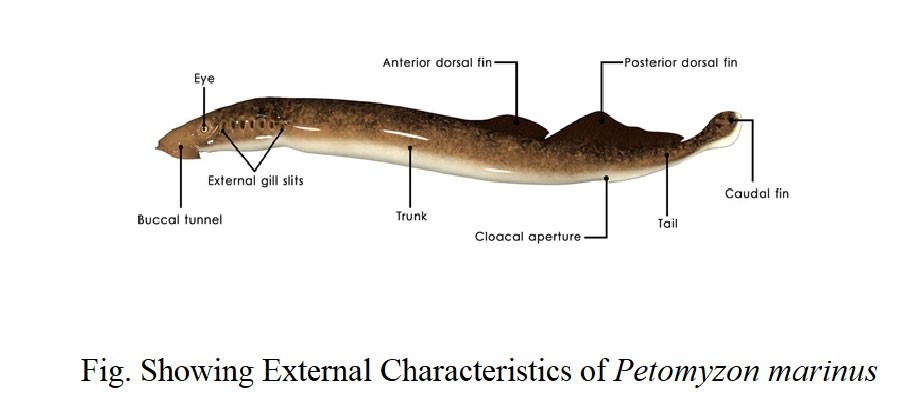
Fin System in Petromyzon:
In Petromyzon paired appendages are absent, the fins present in Petromyzon all are unpaired. On the dorsal side on the posterior end, two dorsal fins are present, they are known as the first dorsal fin and second dorsal fin. The second dorsal fin is connected to the caudal fin. The tail has a caudal fin, the fins are supported by cartilaginous fin rays. The fin rays in the fin are all connected to their base with the covering sheath of the notochord.
Along with dorsal fins and caudal fins, some Petromyzon species have anal fins also. In Lampetra planeri the female has anal fin while in the male it is modified into copulatory papilla.
Suctorial Buccal Funnel:
On the anteroventral side of the head, the mouth opens at the center of a cup-like depression known as a buccal funnel. The cup-shaped buccal funnel has circular muscle fibers which creates a sucking action that makes this buccal funnel into a sucker. With the help of the buccal funnel, the Lamprey can remain attached to the body of prey fishes. The buccal funnel has several teeth in radial arrangements, at the center of the buccal funnel the circular jawless mouth is open. Around the mouth, the teeth have two cups, the bicuspid teeth around the mouth are arranged radially in a concentric row.
The mouth has a rasping tongue which have also epidermal teeth, the rasping tongue bites the flesh and helps in feeding the flesh of the victim fish.
Eyes in Petromyzon:
In Petromyzon the head has two lateral eyes and a single median pineal eye, the lateral eyes remain hidden under the skin in the larval stage.
Aperture on the Body in Petromyzon:
- Mouth: The head have mouth opening on ventral surface on anterior end, the circular jawless mouth is supported by a endoskeletal cartilaginous ring.
- Nostril: In Petromyzon the olfactory sac is connected through the olfactory nerve with a only one median nostril present between the two lateral eyes on the head.
- External Gill Slits: Petromyzon show seven pairs of small circular opening on lateral side of their head, the external gill slits are connected internally with the gill pouches.
- Cloacal Aperture: On ventral side of the trunk, at the junction of trunk and tail a slit like aperture present. The slit like aperture or cloaca have a urinogenital papilla and on the tip of urinogenital papilla a urinogenital aperture present, on anterior side of cloaca anus present.
- Sensory Pores: On the head lateral line organ present, the lateral line organ have large numbers of small pores, these pores are sensory in nature, they present on lateral side of head as well as below the head.
Detailed Study On External Morphology of Petromyzon
Anatomy And Physiology of Petromyzon:
The skin of Petromyzon:
The skin of Petromyzon has multiple layers of cells, both dermis and epidermis layers present, the skin is smooth and slimy due to the secretion of the skin gland. The epidermis has three types of major cells – mucous glands, granular cells, and club cells. The mucous glands are multicellular and their secretion makes the skin slimy, the function of granular cells is unknown, the club cells or kobenzelle cells have an elongated cell body and hyaline cytoplasm.
In the dermis layer, we can see elastin fibers, collagen fibers, pigment cells, and chromatophores. The collagen and elastin fibers are arranged in a circular pattern, the star-shaped chromatophores can migrate and their migration causes the change in skin color.
Muscular System of Petromyzon:
Petromyzon shows segmentation in their body muscle as seen in Branchiostoma. The lateral muscle fibers show ‘E’ shaped muscle segments, myotomes, and those myotomes are separated from each other by myocommas. Each myotome again shows a horizontal partition which divides the myotomes into dorsal and ventral pairs.
The muscles present in myotomes are voluntary and striated, their alternate contraction bends their body sidewise and this alternative bending of the body makes them able to swim actively. The buccal funnel has circular muscle fibers and the tongue has a protector and retractor muscle which makes the tongue move in forwarding and backward direction.
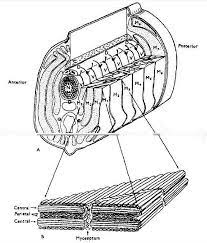
Skeletal System of Petromyzon:
The endoskeleton of Petromyzon does not have any bony endoskeletal structure but there is some endoskeletal structure made of cartilage and the notochord is also an endoskeletal structure in Petromyzon.
Notochord:
Throughout the life Petromyzon shows a notochord, the Notochord is made of cartilaginous tissues and is covered from outside by a connective tissue sheath, the notochord is considered as the main axial skeleton in Petromyzon.
Neural Arches:
On the lateral side of the nerve cord, two rod-like small neural arches of prevertebrae are present.
Cranium:
It is one of the fundamental features of Vertebrate, in Petromyzon the well-developed skull host the brain and other sense organs.
Branchial Basket:
On the lateral side of the head, seven pairs of gill slits are present, gill slits are connected internally to the gill pouches, the gill system is supported by an endoskeletal structure known as the branchial basket.
Annular Cartilage and Lingual Cartilage:
Circular cartilaginous endoskeleton support to the mouth region known as annular cartilage, the tongue also supported by a cartilaginous endoskeletal structure known as lingual cartilage.

Heart Endosketon:
The muscular heart in Petromyzon is covered by the sac of the pericardium, from the outside the heart is protected by a cartilaginous endoskeletal structure.
Detailed Study On Anatomy of Petromyzon (Lamprey)
Digestive System of Petromyzon:
Alimentary Canal of Petromyzon:
The alimentary canal in Petromyzon starts at the circular mouth and ends in the anus, the mouth present at the center of the cup-shaped buccal funnel, and the anus open into the cloacal depression. The circular mouth leads to the buccal cavity and the buccal cavity opens the posterior end into two canals, one is the dorsal esophagus and another one is the ventral respiratory pharynx.
The ventral respiratory pharynx is closed at the posterior end, at the lateral side, the respiratory pharynx has several pairs of internal gill slits. The esophagus on the posterior end joins into the intestine, in the digestive system of Petromyzon stomach absent. But at the start of the intestine, a wide part is considered to be the stomach, a valve present at the anterior end of the respiratory pharynx which prevents the entry of food into the respiratory pharynx.
The intestine has a longitudinal spiral fold known as the spiral valve or typhlosole, the intestine end into the small anus opening through the cloaca.
Digestive Glands of Petromyzon:
At the buccal cavity at the base of their tongue a pair of salivary glands open, the secretion of the salivary gland contain anticoagulant which prevents blood clot during feeding the blood or body fluids of victim fishes.
Around the intestine on the anterior end have a large-sized bilobed liver, gall bladder, and bile duct absent in adult Petromyzon but in Ammocoet larva gall bladder and bile duct present. The glandular epithelium of the intestine has zymogen cells and follicles of Langerhans cells.
The zymogen cells are responsible for secreting pancreatic enzymes and the follicles of Langerhans secret endocrine secretion which controls the blood glucose levels.
Feeding Mechanism of Petromyzon:
Adult Petromyzon are external parasites on the bony fishes, they have a suctorial buccal funnel, with the help of their suctorial buccal funnel they attach to the body of bony fishes. Then their rasping tongue removes a small portion of flesh on the body of the victim fish, they suck the blood or body fluids of the victim fish, the anticoagulant present in their saliva prevent blood clot.
But the wound made by the rasping tongue of Petromyzon on the body of the victim fish makes the fish populations prone to infectious disease or sometimes the victim fish die.
Detailed Study On Digestive System and Feeding Mechanism of Petromyzon
Respiratory System of Petromyzon:
Between the respiratory pharynx and the body wall, there are seven pairs of gill pouches, each gill pouch is connected with the respiratory pharynx through internal gill slits, each gill pouches are separated from each other by inter-branchial septa, each gill pouches open outside through the several pairs of external gill slits on the lateral body wall.
Petromyzon meet its respiratory gases from the water current created by their contractile pharynx. The water enters the buccal cavity then it goes into the respiratory pharynx, then the water moves into the gill pouches. Internally the gill pouches have folding are known as gill lamellae, the internal wall of gill pouches are highly vascularized.
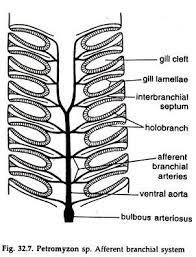
The water present in the gill pouches has dissolved oxygen, the blood capillaries of the internal gill pouch wall take oxygen from the water in the gill pouches and leave the carbon dioxide into the water. In the larval stage, the water from the gill pouches goes outside through the external gill slits but in the adult stage, some water is stored inside the blind sac respiratory pharynx because when the lamprey is attached to the prey fish, the mouth is not available to take the water current inside, then the stored water inside the respiratory pharynx is used for respiration.
Detailed Study On Respiratory System and Circulatory System of Petromyzon
Circulatory System of Petromyzon:
The circulatory system of Petromyzon has a ventral contractile ‘S-shaped heart, arterial system, and vein system. The heart is enclosed by a thick covering of pericardium and supported by a cartilaginous endoskeletal plate, the heart is tubular in the larval stage but in adult Petromyzon, the elongated tubular heart becomes ‘S-shaped to accommodate in confined space.
The ‘S-shaped heart of Petromyzon has one auricle, one ventricle, one sinus venous, and one conus arteriosus. Blood collected from the whole part of the body reaches in the sinus venosus, from the sinus venosus the deoxygenated blood enters into the auricle. From the auricle blood enter into the ventricle, the wall of the ventricle is thicker than the wall of the auricle.
The strong muscular contraction of the ventricle sends the blood from the ventricle to the ventral Aorta, the ventral Aorta gives seven pairs of afferent branchial arteries into the gill pouches. The afferent arteries leave carbon dioxide in the water of gill pouches and take oxygen.
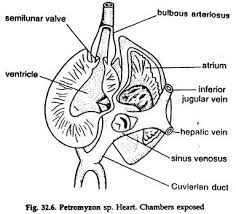
The afferent branchial arteries supply blood to the wall of gill pouches and come out from the gill pouches as efferent branchial arteries. The blood in the efferent branchial arteries is rich in oxygen, oxygen blood from efferent branchial arteries then reach into the median dorsal aorta, the median dorsal aorta then supplies the oxygenated blood throughout the whole body.
Petromyzon has a lymphatic system, hepatic portal system present but renal portal system absent. The blood has circular nucleated hemoglobin rich red blood corpuscles and white blood corpuscles, blood cells origin at the spiral valve, kidneys, and spinal cord.
The median dorsal aorta gives supply to each myotome as segmental arteries, the segmental arteries come out from the myotomes as segmental veins. A special type of cells present in segmental arteries as well as segmental veins known as Chromaffin cells which have similar functions as of adrenal medulla in higher Vertebrate. To reduce the blood pressure in arteries, at the origin of each artery there is a valve but the valve does not present in efferent branchial arteries and renal arteries.
Excretory System of Petromyzon:
The primary excretory organ in Petromyzon is a pair of strap-like mesonephric kidneys. The blood flow through the lumen of the glomerulus and the nitrogenous waste materials pass into the ureter through the uriniferous tubules. The ureter sends the urine to the urinogenital sinus and from there the urine goes outside through the urinogenital papilla.
Nervous System of Petromyzon:
The central nervous system of Petromyzon has a primitive brain and the ribbon-like flat spinal cord. The brain of Petromyzon have three main part, forebrain have two cerebral hemispheres and two large olfactory lobes, the midbrain has a diencephalon with a pineal gland on the dorsal side and an infundibular organ on the ventral side. The midbrain has paired large optic lobes, the hindbrain has rudimentary cerebellum and medulla oblongata.
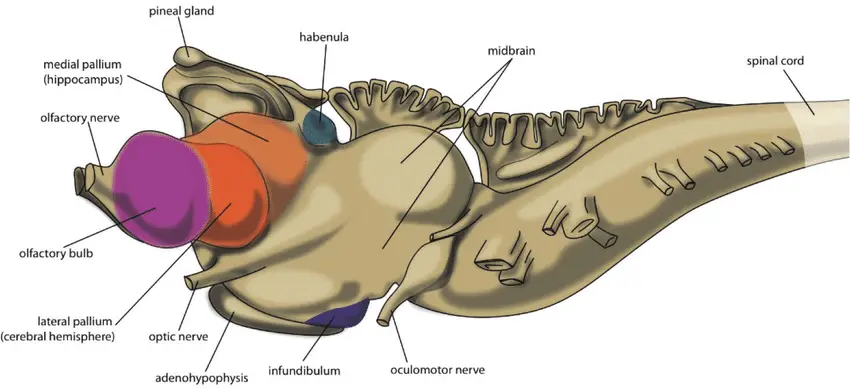
In Petromyzon the number of cranial nerves in 10 pairs and inside the brain four ventricles are present. The ribbon-like spinal cord has no blood vessels and it spinal nerve with separate dorsal and ventral roots. The sympathetic nervous system in Petromyzon is not well developed, the nerve in Petromyzon are all non-myelinated so the rate of transmission of nerve impulse is slow.
Sense Organs of Petromyzon:
- Two large olfactory lobe and paired olfactory nerve are responsible for the sense of smell in Petromyzon.
- The lateral eyes are primitive type, the lateral eyes do not have suspensory ligament and ciliary apparatus but the median pineal eye have well developed lens and pigmented retina.
- Petromyzon have internal ear and the each internal ear have two vertical semicircular canals.
- To take the taste of food they also have taste buds in their internal epithelium of pharynx.
- On the lateral side of head and below the head lateral line of sense organ detect different information about the water.
- The skin of Petromyzon have photosensitive cells which are responsible for detection of light energy, the photosensitive cells are concentrated in the tail region.
Detailed Study On Nervous System and Excretory System of Petromyzon
Reproduction of Petromyzon:
In Ammocoet larva the Petromyzon is hermaphrodite, both oocyte and spermatocytes are present but when the Petromyzon reach sexual maturity only one type of gonad fill most of the place in the abdomen, and the ductules gonads release the gametes in the body coelom, from coelom the gametes reach in urinogenital sinus and from urinogenital sinus the gametes go outside through the urinogenital papilla.
The sexually mature Petromyzon migrate to the freshwater river for reproduction, during spring the Petromyzon becomes sexually mature. Then the male Petromyzon built a nest near the oceanic floor and wait for the female Petromyzon, when male Petromyzon met with female Petromyzon the male Petromyzon winded their tail around the female Petromyzon. Then both male and female Petromyzon release their gametes in the water, the fertilization occurs in water externally, then the adult Petromyzon dies.
Development in Petromyzon:
After fertilization the zygote undergoes successive holoblastic unequal cleavage, then gastrulation takes place. The blastopore in the embryo in Petromyzon forms anus in adult Petromyzon.
The development of the nerve cord in Petromyzon occurs through the method of thickened keel method, a solid plate from the central nervous system which develops a hollow canal.
Ammocoet Larva:
The embryo form a minute transparent Ammocoet larva, the Ammocoet larva are filter feeder and they built ‘U’ or ‘V-shaped burrows. The Ammocoet larva transforms into adult Petromyzon and it takes from 4 years to 7 years, the Ammocoet larva and Petromyzon show much difference between Ammocoet larva and adult Petromyzon.
Ammocoet larva have only one dorsal median fin but in adult Petromyzon, the fin is divided into the first dorsal fin and second dorsal fin, the Ammocoet larva have a transparent body while the adult Petromyzon is opaque. Ammocoet larva is a filter feeder but the adult Petromyzon is an external parasite on the bony fishes.
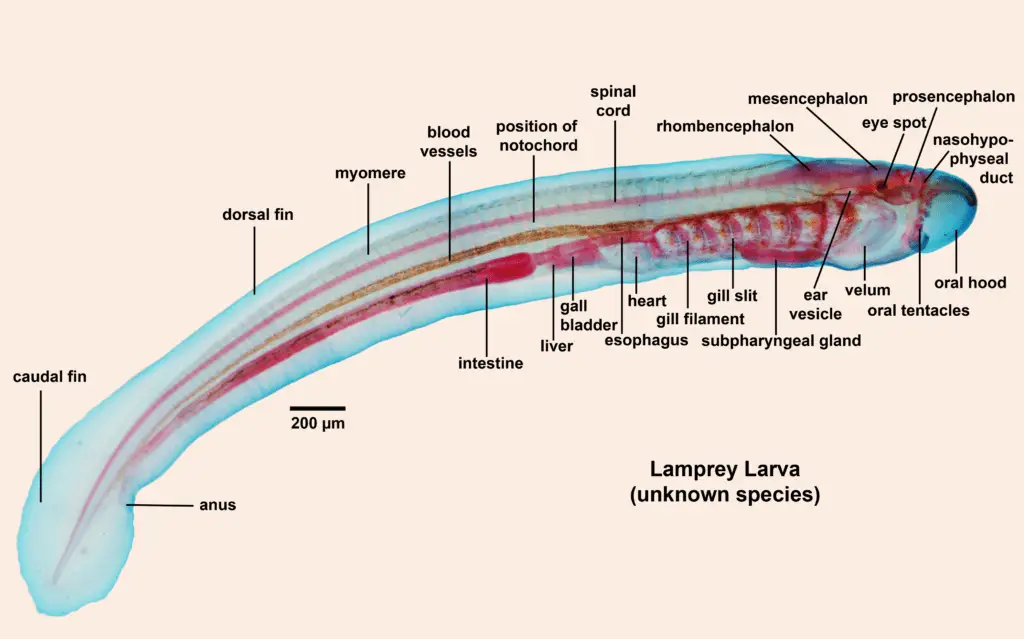
The Ammocoet larva has a mouth bordered with the upper lip and lower lip, the upper lip in Ammocoet larva forms a ridge similar to the oral hood in Branchiostoma. In adult Petromyzon, the upper lip and the lower lip are replaced by the suctorial buccal funnel.
Detailed Study On Development in Petromyzon
Economic Importance of Petromyzon:
The Petromyzon is used as food like fish due to their muscular flesh, especially in Europe and America Petromyzon is used as food on a large scale.
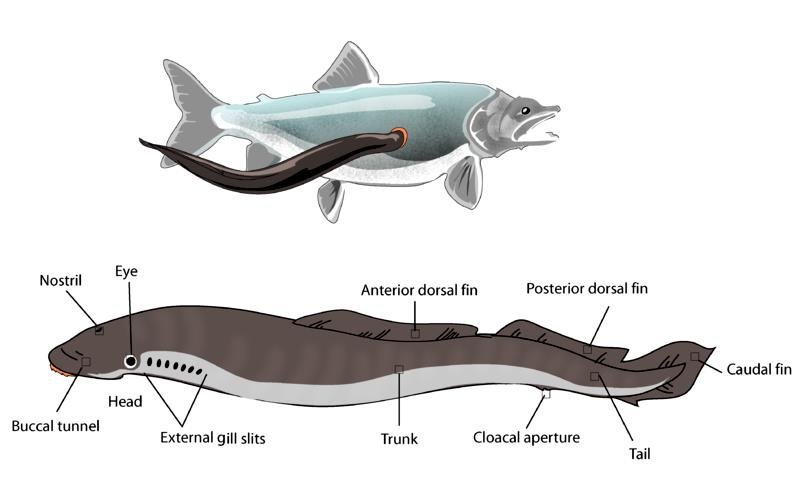
Adult Petromyzon are an external parasite on the bony fishes, the rasping tongue makes would on the body of victim fish which makes them unsuitable for the market. Sometimes the wound on the body of bony fishes made by the Petromyzon causes infectious diseases in fish and sometimes it becomes fatal for the bony fishes, especially when the Petromyzon makes a wound in the abdominal region it becomes more serious.
Detailed Study On Economic Importance of Petromyzon
Hi Everyone!!! Welcome to Imaluop. Imaluop always try to learn some new and he want to share to other people. Here we will try to learn various topics on Science, specially on Biological Sciences.